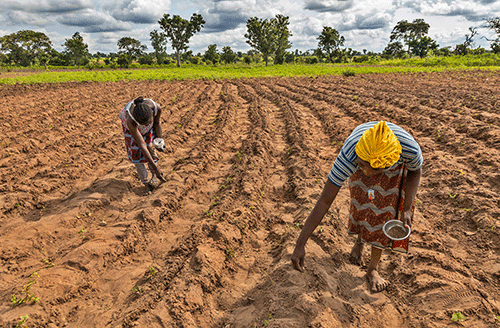KEETMANSHOOP – Government and farmers in southern Namibia, especially in the //Kharas region, remain relentless in their fight against invading brown locusts, which destroy crop fields and intrude on grazing areas for small livestock.
The southern pocket of the country has over the years been the breeding ground for the notorious brown locusts, which are known for causing significant damage to crops and pastures in large parts of southern Africa, including Namibia, Botswana, Zimbabwe and South Africa.
Nelson Ngarizemo, the //Kharas regional head for the agriculture ministry, said they recently found swarms of these locusts on the Aus-Lüderitz and Aus-Rosh Pinah roads and have taken all necessary measures to ensure they do not become a nuisance.
“As we speak now, our teams are on the ground, spraying those whole areas, which are currently only swarmed by hoppers. But once those hoppers develop into migratory flyers, it will be difficult to control them. That is why we, along with our farmers here, are acting now to avoid the situation of the past years,” said Ngarizemo.He further explained that it is imperative for the spraying teams to ensure they prevent the locusts from becoming migratory flyers, as they will then hatch and leave millions of eggs behind for reproduction.
“Our regional office is closely monitoring the situation on the ground and acting upon it accordingly. I must urge our farmers in these areas to be vigilant and start taking precautionary measures before they become worse.”
//Kharas and Hardap regions’ main source of livelihood is livestock farming, with about 80% of inhabitants raising small stock, such as goats and sheep for consumption and income.
Locustana Pardalina, better known as the brown locusts, are infamously known for distressing southern farmers, especially in the areas around Karasburg East and the !Nami#Nus constituency – close to the Aus settlement.
Reoccurring waves
Last year, the country battled the worst wave of brown locusts, which was estimated to have damaged around 1.2 million hectares of cultivated fields in the //Kharas region alone, before spilling over to the neighbouring Hardap region.
At the time, both regions were just emerging from a six-year harsh drought period that ended in 2019; hence, the outbreak of the locust heavily affected the livelihoods and agricultural production of the regions and the entire country.
These areas are receiving daily fly-in, mating egg-laying adult locusts from neighbouring South Africa, particularly when the rainy season is approaching. They are also known for moving to the warmer tarred road surfaces, where they cause fatal accidents when motorists drive over them.
Locust outbreaks in Namibia
During February 2020, the first wave of the African migratory locusts was reported in the north-eastern parts of the Zambezi region, as well as in the Kavango East and West regions.
A second wave was reported in August 2020, which covered and destroyed thousands of hectares in the northeastern and north-central regions of Kunene, Ohangwena, Oshana, Omusati and Oshikoto regions.
In March 2021, a third wave was reported, which comprised African migratory locusts and Red Locust – to a lesser extent – in the aforementioned areas, and the brown locusts in the southern parts.
During that period, it was reported that over 2 000 hectares of cropland and more than 700 000 hectares of grazing fields were negatively impacted by locusts.
– sklukowski@nepc.com.na


